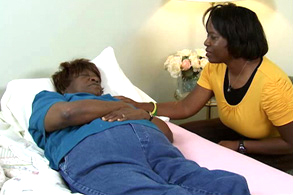Introduction to Recognizing and Relieving Pain

Each of us has had some type of pain in the past. When a person has pain, they feel distress and want relief. No two people experience pain the same. For that reason it is often difficult for a family caregiver to understand and know what to do when the person they care for has pain. How people deal with pain also differs greatly from person to person. We cannot judge someone else’s pain based on our own experience of pain.
Pain is very real to a person. Thus, when you care for a person in pain:
- Respect their feelings
- Accept their pain
- Do what you can to make them more comfortable.
- Determine the level of pain they are having
Listen to the Person. A person’s report of pain is the most reliable sign that he or she is in pain. However, many persons choose not to report or talk about their pain. If a person thinks you doubt he or she is having pain, then they will not talk about it. It is very important for the person to feel like he or she can tell you how they feel.
Show that you care. Simply sitting down and talking with a person about how they feel, lets them know you do care and want to help.
By knowing when a person is in pain, you can act and decide if you need to call a doctor or emergency medical services. This lesson will give you useful information on how to know a person is having pain and some very basic ways that can help to make them feel more comfortable.
Here’s Molly’s Story:

My mother is only 46 years old but she has rheumatoid arthritis really bad. She has had pain from her arthritis for over 2 years now. Some days you can tell she just does not feel well, because she walks more slowly, sits around with drooped shoulders and she does not like to talk a lot. I have found that if I take the time and let her know I want to help, she tells me how she really feels and how bad the pain is. I make sure she has taken her medicines as ordered. Sometimes on her bad days she doesn’t always take her medicines on time. She has the most pain when she first gets up so I try to go over to the house early three days a week to help her with soaking her hands in warm water. It seems to help. I make sure she has taken her medicines like she is supposed to and do some of her housework so she can rest in the middle of the day.